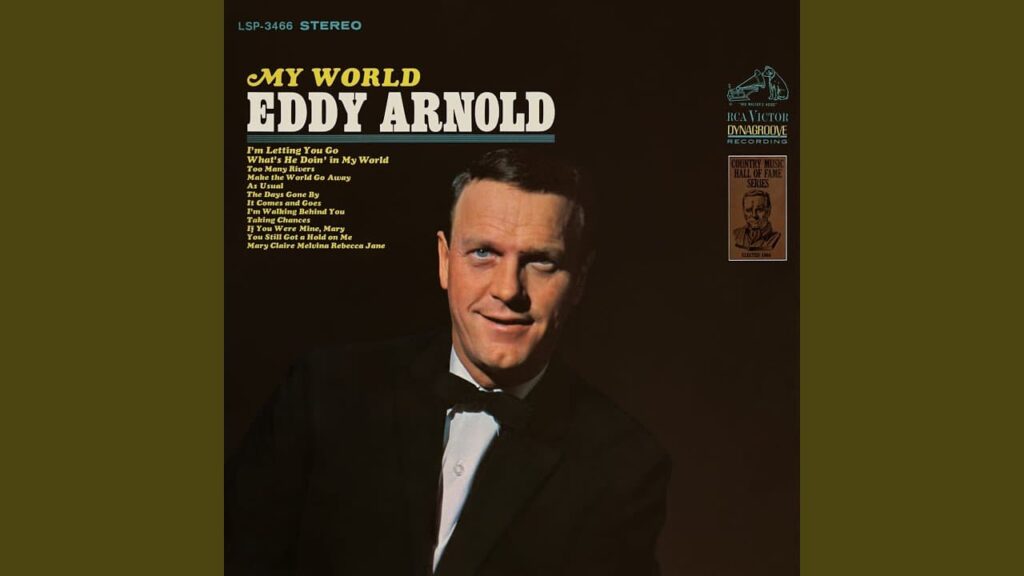
Eddy Arnold’s “What’s He Doin’ in My World”: The Ache of a Love Interrupted
The mid-1960s marked a fascinating period for country music, as the raw honky-tonk sound began to meld with lush, string-laden arrangements, giving birth to what became known as the Nashville Sound. At the forefront of this elegant transformation was Eddy Arnold, a crooner whose smooth baritone voice could convey immense emotion without a hint of bombast. In March of 1965, Arnold released “What’s He Doin’ in My World,” a poignant ballad that would quickly become a cornerstone of his legendary career. This powerful track didn’t just climb the charts; it soared, reaching Number 1 on the U.S. country chart, marking his first chart-topper in a decade and staying there for two weeks. Its immediate embrace by listeners highlighted the song’s universal appeal, tapping into a raw, relatable vulnerability that resonated with hearts across the nation.
“What’s He Doin’ in My World” is a masterful exploration of suspicion, jealousy, and the painful realization that a beloved relationship is slipping away, potentially due to the presence of another. The song’s narrative is a poignant monologue from a man grappling with the unsettling sight of a rival encroaching upon his most precious emotional territory. “What’s he doin’ in my world? What’s he doin’ holdin’ my world?” sings Arnold, his voice imbued with a quiet ache that speaks volumes. It’s not about anger or aggression, but a deep, simmering hurt and confusion, a yearning for answers that might only bring more pain. The “world” here isn’t a geographical place but the intimate, emotional space shared by two people—a world now seemingly infiltrated by an unwelcome third party. For anyone who has ever felt the sting of a wandering eye, or the unsettling sensation of seeing someone else take a place once exclusively their own, this song hits with profound emotional accuracy. It articulates that unspoken dread, the fear of replacement, and the sorrow of a love that feels threatened.
The story behind “What’s He Doin’ in My World” is rooted in Eddy Arnold‘s conscious effort, alongside legendary producer Chet Atkins, to redefine his sound and reach a broader audience. By the mid-1960s, Arnold had already enjoyed immense success, but the musical landscape was shifting. Atkins, known for his innovative “Nashville Sound” production techniques, aimed to sweeten country music for pop appeal, incorporating strings, background vocals, and a smoother delivery. “What’s He Doin’ in My World,” written by the talented trio of Carl Belew, Billy Joe Moore, and Eddie Bush, perfectly fit this evolving sound. Recorded on January 13, 1965, the track epitomized the lush, sophisticated arrangements that would define Arnold‘s output for the remainder of the decade. This particular song wasn’t just a commercial triumph; it was a testament to Arnold‘s versatility and his ability to convey deep emotional nuance even within a polished, orchestral setting. It showcased how country music could be both traditional in its storytelling and modern in its presentation, appealing to listeners far beyond its traditional boundaries.
For those of us who recall the gentle hum of the radio during the twilight hours, or the easy listening sounds that accompanied family road trips, “What’s He Doin’ in My World” evokes a specific kind of wistful nostalgia. It transports us back to an era where the sincerity of a crooner’s voice could capture the most complex human emotions. It wasn’t about flashy theatrics but about the power of a well-crafted lyric delivered with impeccable grace. Eddy Arnold had a unique gift for making every listener feel as though he was singing directly to them, understanding their unspoken anxieties and heartaches. This song, with its elegant melody and poignant lyrics, remains a beautiful, if bittersweet, reminder of vulnerabilities inherent in love. It’s a sonic photograph of a relationship teetering on the edge, a reminder of the quiet pain of jealousy, and the enduring power of a truly classic country ballad to resonate across generations. It stands as a timeless example of Arnold’s artistry, showcasing why he remained one of country music’s most beloved and enduring figures.